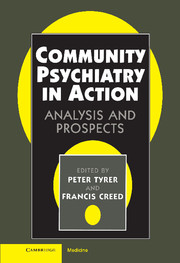Book contents
- Frontmatter
- Contents
- List of contributors
- 1 Essential issues in community psychiatry
- 2 Evaluation of community treatments for acute psychiatric illness
- 3 Synopsis of the Daily Living Programme for the seriously mentally ill: a controlled comparison of home and hospital based care
- 4 Evaluation of a complete community service
- 5 Early intervention study of psychiatric emergencies
- 6 Evaluation of psychiatric services: the merits of regular review
- 7 A home based assessment study
- 8 Home treatment as an alternative to acute psychiatric inpatient admission: a discussion
- 9 The toxicity of community care
- 10 Community mental health services: towards an understanding of cost-effectiveness
- 11 Future research strategies
- Index
4 - Evaluation of a complete community service
Published online by Cambridge University Press: 06 July 2010
- Frontmatter
- Contents
- List of contributors
- 1 Essential issues in community psychiatry
- 2 Evaluation of community treatments for acute psychiatric illness
- 3 Synopsis of the Daily Living Programme for the seriously mentally ill: a controlled comparison of home and hospital based care
- 4 Evaluation of a complete community service
- 5 Early intervention study of psychiatric emergencies
- 6 Evaluation of psychiatric services: the merits of regular review
- 7 A home based assessment study
- 8 Home treatment as an alternative to acute psychiatric inpatient admission: a discussion
- 9 The toxicity of community care
- 10 Community mental health services: towards an understanding of cost-effectiveness
- 11 Future research strategies
- Index
Summary
Introduction
The research in Sparkbrook, Birmingham, differs from the others in this volume in that it was not a randomised controlled trial but an evaluation of a total service. An audit of the service has been performed over several years and a research project has just been completed which is a comparison of Sparkbrook with another total service; Grad & Sainsbury (1968) used a similar design. This design has the disadvantage that the two samples being compared may have different characteristics but it has the advantage that one element of a service is not being picked out and compared with another. It is, for instance, rather artificial to compare inpatient care with day care because in clinical practice a range of treatment options are available. The Sparkbrook service has been running for 6 years and details have been reported elsewhere (Dean & Gadd 1990).
Background
Sparkbrook is a small inner city, deprived electoral ward with a population of 25 725, a Jarman score of + 62 and an unemployment rate of 30% (at October 1991). Over 50% of the population are from New Commonwealth or Pakistan (1981 census).
The Resource centre which is situated in the middle of the locality is the focus for all activities. It provides day facilities for approximately 30 people a day: the services provided are a combination of those which would normally be expected in a day hospital and in a day centre. There is a drop-in facility with a relaxed, unstructured, ‘cafe-type’ atmosphere for people with long-term disability.
- Type
- Chapter
- Information
- Community Psychiatry in ActionAnalysis and Prospects, pp. 45 - 54Publisher: Cambridge University PressPrint publication year: 1995
- 1
- Cited by



